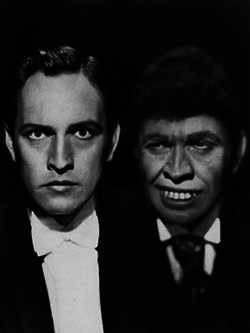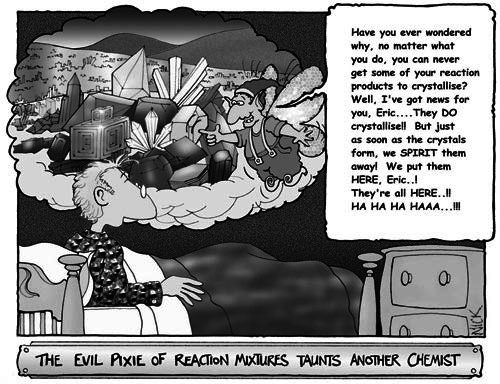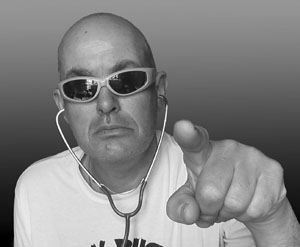Alternative medical practitioners often start out in the mainstream, but other currents may take them into new channels. This article is adapted from a presentation at the 2006 NZ Skeptics conference.
A recent survey of general practitioners found that about one third practised some form of complementary and alternative medicine (CAM). The term CAM refers to a range of medical treatments which are considered outside the realms of conventional medicine because they remain scientifically unproven. Why is it that so many GPs get involved with CAM? Should we accept the term CAM? There can surely be only proven and unproven medical treatments.
I entered medical school in 1971 when I was 19. For the next six years I studied and was taught that doctors were supposed to talk to people, examine them and make a diagnosis. This is quite a sound approach for hospital-based medicine but not very useful in general practice which is where I found myself.
Many general practice surveys have shown that a large proportion of patients do not have a clear diagnosis. These people are often referred to as the ‘worried well’. They have symptoms rather than diseases. There are GP abbreviations for common conditions such as TATT syndrome for ‘Tired all the time’. People who attend regularly with a litany of such complaints are often referred to as ‘heart sink’ patients.
In my own general practice I had the same sort of patients. I became dissatisfied with my inability to diagnose and treat problematic conditions and was in the right frame of mind to try something new, something alternative. Acupuncture seemed to offer all the answers.
I spent a week training in Auckland. The trainer had palatial rooms and drove a Mercedes. He was a charismatic figure. I was impressed! However, some things troubled me. I noticed that acupuncture points seemed to be very close together and it was time-consuming having to refer to charts to locate the correct points. Why use a particular set of points? The trainer said to me “Don’t worry John, acupuncture is very forgiving”.
My scientific curiosity was provoked and I immediately wondered whether it mattered at all where acupuncture needles were placed. I found that it didn’t and got the same results just sticking them in at random.
I soon lost interest in acupuncture.

The great thing about learning from your mistakes is that you recognise them when you make them again. My next experiment was with spinal manipulation. I attended a weekend workshop run by another GP who had written a book on the subject. The techniques were easily learned and I was soon able to produce pleasing noises from any part of the spine. The results could be spectacular and soon my appointment books were full and I was making a lot of money. I realised I had unwittingly stumbled across the secret of chiropractic and osteopathy. Create a need or a belief and then fill it.
I stopped doing spinal manipulation when I had a patient faint after I had manipulated her neck. I thought I had either damaged the spinal cord or damaged arteries in her neck.
There is a known association between manipulation of the neck and stroke. The shearing forces used in manipulation of the neck are capable of damaging the blood supply to the brain. It was always believed that this complication was rare but when a stroke unit started specifically enquiring about prior chiropractic or osteopathic manipulations they found that the incidence of stroke was ten times higher than previously suspected. A sore neck will get better on its own with no risk of such complications. I think I was wise to abandon spinal manipulation.
Case Studies
All of the information for the following case studies has come from the public domain. I have referred to some patients as index patients where for some reason they became important either through media interest or disciplinary proceedings.
Case One
Dr A became interested in Vega testing and homeopathy when he was about 35. The Vega test machine is a derivation of the Wheatstone bridge, an instrument used to measure resistance. Most alternative medical devices are derived from legitimate scientific instruments.
Testing of a small child involved the application of one electrode to the mother’s left middle toe while she held the other electrode in one hand. The child, who was not actually examined, sat in her lap until he became bored and ran around the surgery. Dr A directed questions telepathically to the mother with the responses being analysed by the Vega machine. This revealed allergies as well as evil miasmas which were treated by homeopathic solutions. Homeopathic solutions contain only water but they can also contain a lactose base. The child had lactose intolerance and suffered what was described as a violent gastrointestinal disturbance.
The next child was tested in the same manner and the diagnosis was further evil miasmas from a promiscuous grandmother but this time the mother was also diagnosed with latent diabetes and cancer of the cervix.
Another child with suspected allergies and asthma was diagnosed as having selenium deficiency, allergies to wheat, caffeine and dairy products, as well as more evil miasmas inherited from criminal ancestors. The Vega machine was obviously working to capacity on this day because Dr A was also able to predict for the child diabetes at age 40, and Alzheimer’s at 70, provided he did not succumb from the possibility of a fatal motor vehicle accident at 17. However, the machine failed to see the heavy hand of the Medical Practitioners’ Disciplinary Committee (MPDC) and Dr A was rebuked and heavily fined.
Case Two
Dr B was aged 32 years and a GP at the time of an emerging interest in CAM.
As a fourth year medical student, he was involved in the care of a patient who suffered a fatal drug reaction and died. At the time Dr B said “I was pretty horrified and from then on I questioned the whole philosophy of medicine.” Distraught, he dropped out for a while and then began using nutritional supplements in general practice. He consulted with a lawyer to avoid any breach of medical ethics and continued using nutritional supplements, hair analysis and chelation therapy.
The index patient was a 62 year old with terminal brain cancer who was not confident about proven medical treatments. He was diagnosed with heavy metal poisoning on the basis of hair analysis and treated with chelation therapy and nutritional products for which the GP was getting a 25 percent commission from Neo Life, a multi-level marketing organisation.
The patient’s son complained that his father was spending $800-1000 per month on these.
Dr B was investigated by the MPDC and Consumer but there was no adverse finding in law because Dr B had demonstrated the “honesty and good faith” required by the Medical Practitioners Act. Dr B said “there are some large powers that have financial interests in maintaining general practice as it is, with doctors writing a lot of prescriptions.” The irony of this appears to have been overlooked by Dr B whose own financial interests appeared to be flourishing.
Case Three
Dr C practises electroacupuncture using black box devices such as the Vega machine to diagnose mercury poisoning and other environmental illnesses.
Dr C is anti-immunisation, anti-fluoridation, anti-dental amalgam and claims that ascorbic acid (vitamin C) “is uniformly effective in treating all of the childhood illnesses including hepatitis and polio.”
In 1995 I complained to the MPDC about his anti-immunisation activities. Off the record, I was told that at least 30 other doctors had written similar complaints but the MPDC was powerless to act until a patient either made a complaint or was harmed.
Case Four
Dr D is also a GP who graduated in 1977. He became interested in an unconventional approach following a mysterious family illness which allegedly turned out to be arsenic poisoning, an unlikely diagnosis in my opinion.
Dr D took up using a combination of Bi-Digital O-Ring Test (BDORT) or peak muscle resistance testing as well as homeopathy and prayer.
Some patients complained they had been harmed by his treatments and duly complained to the MPDC. During this hearing one of the expert witnesses offered to devise a blind trial of BDORT and Dr D declined. Dr D was struck off the medical register and fined.
Some time later he was back for a second appearance. This time there was a complaint from a patient who had been suffering from abdominal pain, flatulence and was passing blood in his bowel motions. The patient was seen 19 times and diagnosed with: salmonella, campylobacter, helicobacter, bowel bug, blood fluke, Tordon poisoning, amoebic infection, colitis and irritable bowel syndrome.
He was seen by another doctor who organised a colonoscopy which revealed terminal bowel cancer.
So why do so many GPs get involved with CAM?
Doctor factors
There is still a great deal of uncertainty in medicine. Some doctors find it difficult to cope with uncertainty and are attracted to any pseudoscience that ends uncertainty and reduces complexity by relying on a simple diagnostic or treatment method.Some become disillusioned with medicine due to bad experiences in training or become unhinged by life events.
Psychologists refer to the “power of vivid instances” and this can apply equally to both good and bad experiences. Medical students are selected from the general population and bring with them their own belief systems.
Some doctors have a powerful personality and although they may be aware of and sensitive to the placebo effect this is no guarantee against becoming subject to a belief in their own placebo. Some doctors practising CAM have been challenged to put their methods to the test. They will generally refuse; since these doctors know that their methods work, they conclude there must be something wrong with the scientific method which must therefore be avoided. They will argue that their belief system works through some as yet unknown mechanism. This argument has been described as loopholeism or “the plea for special dispensation”. It is such a common argument that when it is invoked it is diagnostic of quackery.
There is no doubt that some doctors are motivated by money and this wealth becomes a de facto validation of their practices.
I could not find any comparable surveys of specialists who are actively involved with CAM but I suspect that few specialists would be, because the focused nature of specialist practice would tend to exclude unproven treatments.
Patient Factors
The essentially psychosomatic symptoms of the ‘worried well’ have changed very little from the 1920s, with pain and fatigue being dominant symptoms.
There is a huge market for all sorts of unscientific treatments and people are ready and willing to pay for these.
There has been a loss of the folk culture of knowledge which gave people commonsense understanding of their own bodily sensations. As a child I can hardly remember being taken to a doctor. My mother treated our colds, sprains and other injuries. Now people demand antibiotics, X-rays and physiotherapy.
The pharmaceutical industry has not been slow to exploit this by promoting drugs for symptoms rather than diseases. For example, indigestion is now called gastro-oesophageal reflux disease and widely treated with omeprazole or Losec.
Modern medicine can exclude organic illness with a high degree of certainty. Psychological illness is neither fashionable nor acceptable. Symptomatic individuals attribute their symptoms to some external cause such as poisons or toxins and there is a constant background of conditions such as total allergy syndrome and yeast infection, punctuated by epidemics such as Chronic Fatigue Syndrome and Occupational Overuse Syndrome. Because such conditions are largely rejected by conventional medicine they provide a fertile source of income for CAM treatments.
The treatment of cancer is often unpleasant and again it is hardly surprising that sufferers are attracted by the promise of painless treatments with good results. The Lyprinol scandal is a case in point. People are living longer and tend to accumulate a range of chronic disorders such as arthritis, insomnia, and diabetes. Chronic diseases typically undergo a cyclical course with peaks and troughs and the trick is to provide a CAM treatment during a trough so as to coincide with a naturally occurring improvement.
Lessons from Medical History
One hundred and fifty years ago you could easily argue that most doctors were quacks. Medicine had little scientific basis and treatments were often dangerous if not lethal. It was safer to have no treatment at all rather than subject yourself to bleeding or purging. Homeopathy was much safer and the doctors who chose such treatments would have had a following.
As medicine built on a secure knowledge base, the advent of the randomised placebo controlled trial (RPCT) meant the arrival of effective treatment.
Such trials are a threat to unscientific treatments and are able to refute them. A common argument is that RPCTs cannot be used to evaluate homeopathy, for example, because the homeopathic treatment is especially tailored for each patient. This has led to the testimonial becoming the form of evidence favoured by alternative medicine.
People are not comfortable with the idea that they have a psychosomatic condition. It’s easier to admit you have a broken arm than that you are depressed. In the 20th century the dominant theme is the loss of the nuclear family with associated isolation and a loss of intimacy leading to a great fear of the outside world, expressed as agoraphobia and multiple chemical sensitivity.
Perhaps the greatest lesson from medical history is the way various ideas are constantly recycled. The early 1900s was the era of autointoxication from the large bowel. People have always been obsessed by constipation and at one stage a fashionable surgeon, Sir Arbuthnot Lane, was performing total colectomies for this spurious condition. The operation soon fell into disrepute but the theory of autointoxication has undergone a revival with ‘colonic cleansing clinics’.

During the 19th century Parliament recognised the need for some kind of registration of doctors in order to give them some legal standing and acknowledgment of proper medical training. The first medical registration act passed in 1858 included a ‘homeopathy clause’ that has persisted to this day, which says in effect that no doctor can be found guilty of misconduct merely because of a particular practice or belief if he has acted honestly and in good faith.
In practice this means that registered medical practitioners can practise the most blatant quackery and get away with it provided that they don’t harm any patients. Some countries such as Canada have dropped the homeopathy clause and NZ should do the same.
Media/Internet/Technology
Doctors used to be an authoritative source of health information. Now anyone can go online and access health information. Informed choice has become fashionable. An element of consumerism has crept into medi-cine and as well as being GPs, doctors have to run a successful business. CAM is a lucrative area and if people are prepared to pay it’s hardly surprising that many doctors cater for this demand. A recurring theme is natural versus unnatural. There is a nostalgia for the natural remedies used by Rousseau’s noble savage. Many herbal remedies vary widely in composition. Some brands of ginseng don’t contain any active ingredient at all. At least you get what’s on the label when you fill a prescription for digoxin.
Conclusion
There is something about general practice which attracts an interest in CAM. The case studies are extreme but there are plenty of GPs continuing to use such diagnostic methods and treatments. Is it acceptable for medical graduates with a science degree to be allowed to carry on in this manner? Should we amend the relevant legislation so they can’t? I welcome your thoughts and suggestions.



